TelescoMicro ED6×18D was known to the Coolpix community in mid 2002; however, it was not available in the USA until Nikon Mall started selling it in the summer of 2003. It is expansive (i.e., $329.00 plus shipping) and includes a tripod adapter. This lens is a 6X monoscope, and uses ED (i.e., extra-low dispersion) glass to reduce chromatic aberration, which is certainly very attractive to many high power monoscope/teleconverter users. Here is my personal report. Since detailed specification can be found here, this page will not repeat the details.
The left image below was taken with a Coolpix 4500 at the maximum focal length of 155mm (35mm equivalent), and the right one was taken using the TelescoMicro with a combined focal length of 930mm = 6×155mm. Its 6X power is clearly seen. Light fall-off can be seen in the corners in the image of TelescoMicro; but, it is not very significant. In what follows, we shall take a look at the performance of the TelescoMicro at various distances and its close-up capability. When it is necessary, we will use Kenko 6X for comparisons. All images were taken with aperture-priority at F8.2, White Balance Auto, matrix metering, image adjustment NORMAL, Saturation Control NORMAL, Image Quality FINE, Image Size 2272×1704, Sharpening Off and Noise Reduction Off.

|
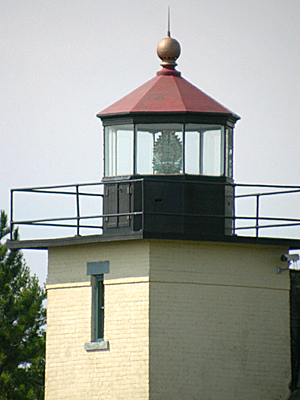
|
|
| Coolpix 4500 @ 152mm | |
Coolpix 4500 @ 152mm and TelescoMicro |
The complete set of the lens, as shown in the following image, consists of a carrying case and strap, front and rear caps, 32-37mm step-up ring, close-up lens, rubber eyepiece, and the lens ED6×18D. Click here to learn the meaning of 6×18. Therefore, this TelescoMicro set seems more complete than any other monoscopes for Coolpix 9xx and 4500 series cameras. Moreover, all components are very well built and feel very solid.
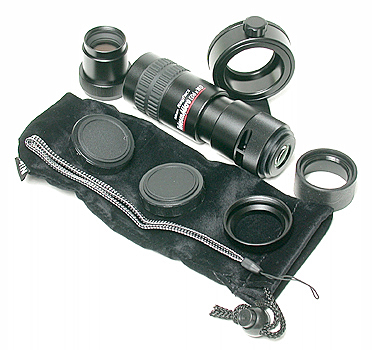
The TelescoMicro is actually a monoscope plus a close-up/micro zoom lens. Note that the eyepiece is on the lens in the package (below left), and the front (resp., rear) cap is on the front end (resp., eyepiece) of the lens. To use the lens on a 9xx or 4500, take the eyepiece off the lens (below right). This reveals two male threads on the lens. The outer one, which has a size of 32mm, is for the eyepiece and tripod adapter to use, while the inner one, which has a size of 28mm, is for mounting the lens on a camera. Note that Coolpix 5000 can also use TelescoMicro; however, you will need a UR-E6 adapter ring.
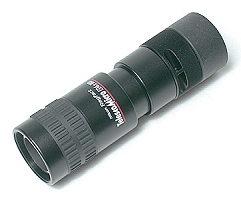
|
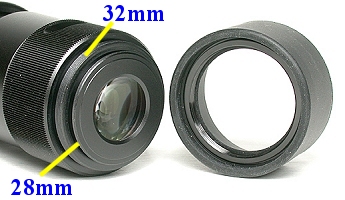
|
If you wish to use the tripod adapter, you must put it in place before mounting the lens to your camera. The following images show the front (a) and rear (b) of the tripod adapter. The lens, without the eyepiece, is first screwed onto the tripod adapter from the front side. Image (c) below shows the lens is screwed half-way into the tripod mount. As you can see, the tripod mount uses the 32mm thread. Once the lens is firmly in place, the 28mm thread of the lens is free to use as shown in (d).
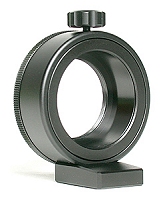
|
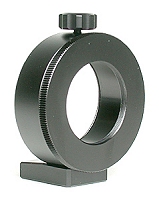
|
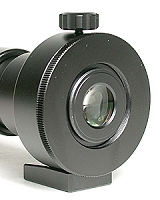
|
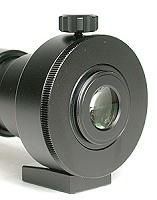
|
| (a) | (b) | (c) | (d) |
Then, the lens is screwed onto the camera as shown in (a) below. Once it is done, one can loosen the locking screw of the tripod adapter, adjust for the proper orientation, and then fasten the locking screw. The following images (c) and (d) show the lens on a 4500 without and with the tripod adapter. The tripod adapter can be mounted on a tripod. If the orientation of the camera has to be adjusted, one can loosen the locking screw, make adjustment and fasten the locking screw. This is very flexible and convenient.
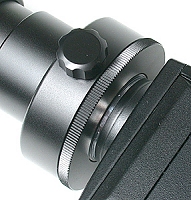
|
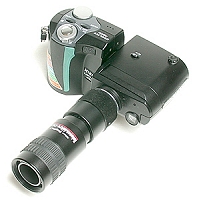
|
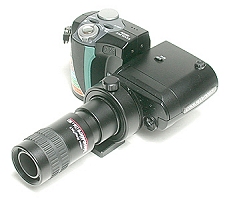
|
| (a) | (b) | (c) |
TelescoMicro has a very nice design. The front element of the lens is deeply recessed as shown in (a) below, and the lens barrel serves as a very good lens hood. This is much better than CrystalVue 8X, Kenko 8X and Kenko 6X. If you look at the front end of the lens carefully, you will see there are two threads. The outer female thread has a size of 32mm, while the inner male thread has a size of 24mm. The outer (resp., inner) thread is used by the supplied step-up ring (resp., close-up lens). The step-up ring is a 32-37mm ring as shown in (b) below. With this step ring mounted, you will be able to use many 37mm or larger lens accessories such as filters or another monoscope/teleconverter. The added length of the step ring will also help increase the "hood" of this lens as shown in (c) below.
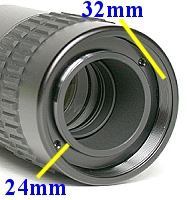
|

|
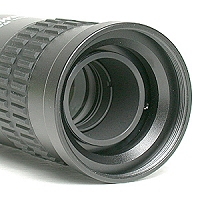
|
| (a) | (b) | (c) |
Focusing with TelescoMicro is very easy without any difficulty. The focusing ring is large (image (a) below) and its operation is smooth. This is much better than CrystalVue 8X, Kenko 8X and Kenko 6X. In about a half-turn, the lens focuses from infinity to its minimum focusing distance of approximately 35cm. Moreover, pushing the focusing out as shown in image (b) below makes the lens in close-up mode. Therefore, when focusing for general shots, pull the front part of the lens all the way back and adjust focus with the focusing ring. When the subject-lens distance is less than 30cm or so, push the front part of the lens out to have an approximate focus and use the focusing ring to fine tune the focus. We shall discuss the close-up and microscope capability of this lens later.
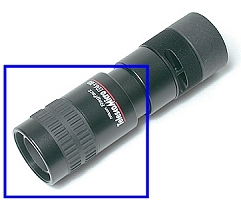
|

|
| (a) rotate to focus | (b) push/pull for close-up |
While TelescoMicro is larger than the Kenko 6X, given its additional close-up and microscope-like capability, it is not too large, especially that the length of this lens when fully extended in general shooting mode is still short compared with the CrystalVue and Kenko. Image (a) below shows all four lenses when they are focusing at infinity. As you can see, the length of Kenko 6X is about half of the TelescoMicro, and the other two 8X lenses and the TelescoMicro have similar length. However, when these lenses focus to its shortest distance, the TelescoMicro extends about 1cm, while the others change length significantly as shown in image (b) below.
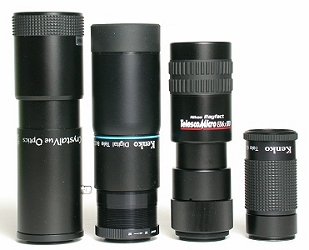
|
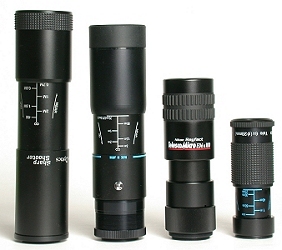
|
| (a) | (b) |
But, one thing bothers me sometimes. On most lenses, the focusing ring will stop turning when it is at the shortest distance or the infinity position. However, due to the special push-pull design of TelescoMicro, whether it is in general shooting position or in close-up, the focusing ring is not locked in the shortest distance nor the infinity position. More precisely, even though the lens is focused at the shortest distance position, one still can turn the focusing ring. Between the shortest distance and infinity position, turning the focusing ring only causes the front portion of the lens to turn. Once the ring is turned to its shortest distance or infinity position, turning the focusing ring will engage the close-up portion and both portions turn at the same time. This strange way of operation sometimes may surprise a user because s/he may be confused by why the lens is not focusing!
In this test, I will try to determine the image quality of both lenses with a focus distance near infinity. The scene is the one I used in the comparison of a Russian 14X, CrystalVue 8X, Kenko 8X and Ken 6X. Click here to see the details. The following image was taken by one the two 6X monoscope with the center portion marked in yellow and lower right corner marked in red. These are the areas we will use for image quality comparison.
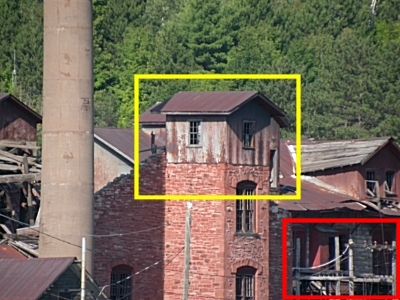
|
| Click here to download a compressed .zip file of the original images (2.18mb) |
The center portion of each image is shown below. From the siding and brick wall textures, it is clear that the Kenko 6X is slightly sharper than the TelescoMicro. The image of TelescoMicro is a little soft; however, its color rendition is warmer and provides more color details. On the other hand, the image of Kenko 6X does not have the rich tonality. Moreover, the contrast in the TelescoMicro image is also higher, which may be a typical result of using ED glass element.

|

|
|
| TelescoMicro | |
Kenko 6X |
| Click on the image to see the original, unedited image | ||
The following images show the lower right corners. Now, the situation is entirely different. The one taken by the TelescoMicro is much better than that of the Kenko 6X. The TelescoMicro image has a fairly accurate color rendition and reveals more details vividly. The Kenko image seems to have a touch of blue/violet, is very soft and shows chromatic aberration.
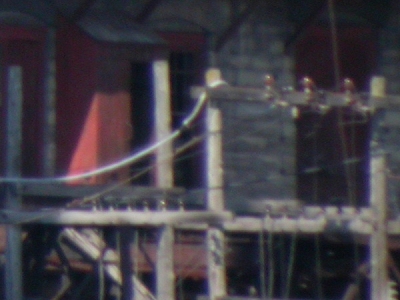
|
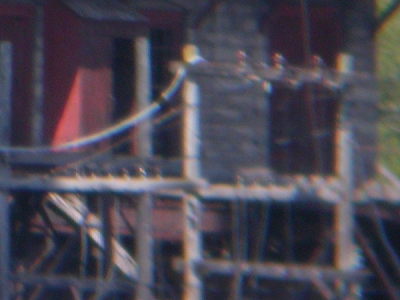
|
|
| TelescoMicro | |
Kenko 6X |
| Click on the image to see the original, unedited image | ||
The following is another scene for this test. Again, the center and right portions that will be used in this test are marked in yellow and red, respectively.

|
| Click here to download a compressed .zip file of the original images (2.14mb) |
The follow images are the center portion. Again, it is clear that the Kenko 6X is a little sharper than the TelescoMicro. This is even clearer if you look at the tree in the lower left corner. On the other hand, the TelescoMicro offers higher contrast and more saturated and warmer color.
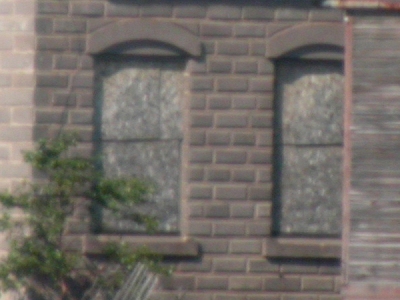
|
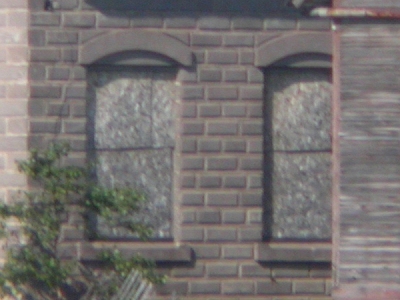
|
|
| TelescoMicro | |
Kenko 6X |
| Click on the image to see the original, unedited image | ||
The following images show the right edge portion. Similar to what we saw earlier, the TelescoMicro is definitely better in sharpness and contrast. Chromatic aberration in the TelescoMicro image is lighter than in the Kenko image. It is interesting to point out that the TelescoMicro (resp., Kenko) has a greenish (resp., purple) fringe along the vertical corner of the walls and a purple (resp., greenish) fringe along the edge of the roof. Of these fringes, those of the TelescoMicro are much weaker than those of the Kenko.
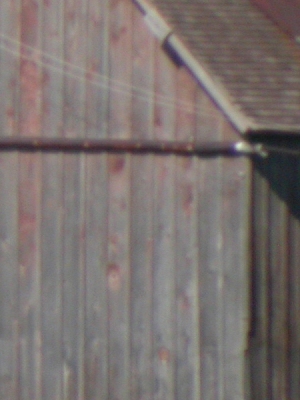
|
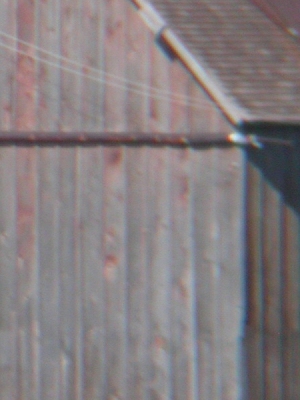
|
|
| TelescoMicro | |
Kenko 6X |
| Click on the image to see the original, unedited image | ||
This test is for a subject that is closer than the previous one. In fact, this subject appeared in our tests and comparisons frequently. With this scene, we want to know further about the sharpness and chromatic aberration of both lenses. Again, we choose a center area and an edge area as marked in yellow and red, respectively.
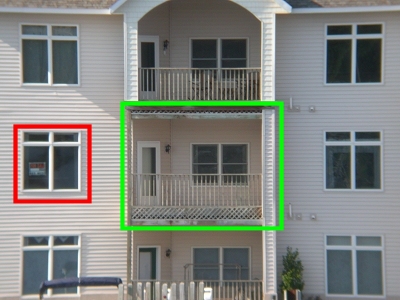
|
| Click here to download a compressed .zip file of the original images (2.23mb) |
The following images are the center portion. Just like the previous comparison, the Kenko 6X is slightly sharper than the TelescoMicro and provides more details. The tonality of both images are about the same.

|

|
|
| TelescoMicro | |
Kenko 6X |
| Click on the image to see the original, unedited image | ||
Again, the edge and corner are the weak spots of the Kenko. The telephone number posted on the window in the image of TelescoMicro is barely readable; but the one in Kenko's image is so blurred that the number is not readable. Moreover, the Kenko exhibits more color fringing than the TelescoMicro does.
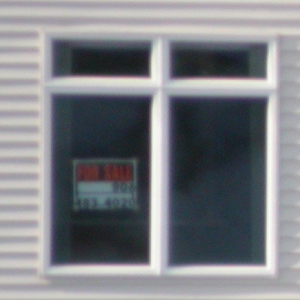
|
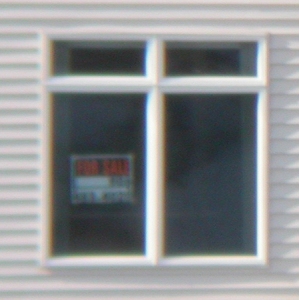
|
|
| TelescoMicro | |
Kenko 6X |
| Click on the image to see the original, unedited image | ||
In this test, a poster is the subject and the camera-subject distance is about 18 feet. This distance was chosen because, it my opinion, it is a very commonly used one (e.g., in the zoo). The following image shows the scene and the center portion in red and the right portion in blue.
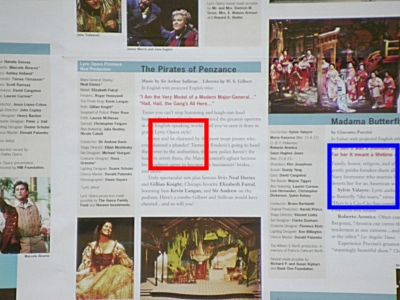
|
| Click here to download a compressed .zip file of the original images (2.17mb) |
The following images show the center portion. In terms of sharpness, the Kenko-6X performs slightly better than the TelescoMicro. The image by the TelescoMicro seems lack of contrast and looks flat. This is a surprise because the use of ED glass normally produce higher contrast and more saturated results.
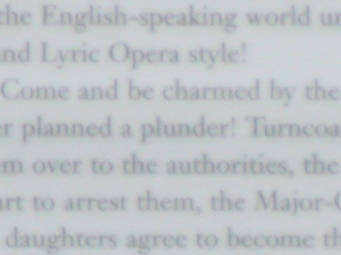
|
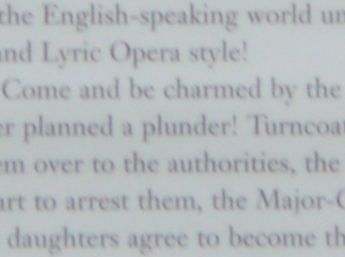
|
|
| TelescoMicro | |
Kenko 6X |
The following shows the right edge portions. Now, the TelescoMicro looks much better and contrastier. In fact, in terms of sharpness, the center portion and right edge portion do not show much difference. Note that light fall-off is clearly seen due to the brightness difference between these two portions. The Kenko 6X image is poor. Some words are not readable due to softness and greenish fringes can be see in the right side of each boldface letter.
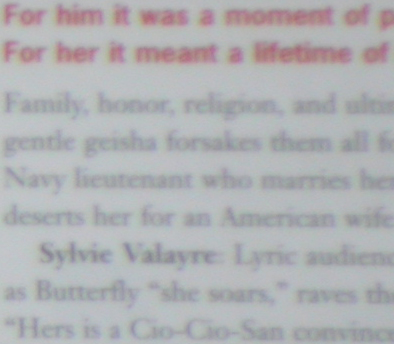
|
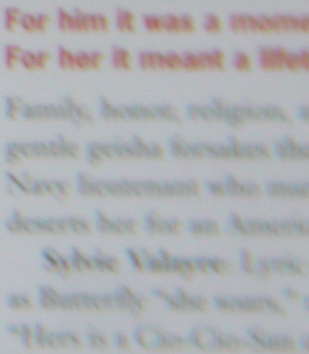
|
|
| TelescoMicro | |
Kenko 6X |
The shooting distance of this test is about 10 feet. The subject is a government announcement published in a newspaper as shown below. We shall look at the center portion marked in red and the upper-right corner marked in blue.
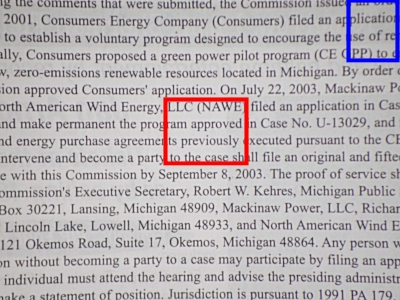
|
| Click here to download a compressed .zip file of the original images (2.04mb) |
The following images show the center portion. The one by Kenko 6X has higher contrast and appears sharper than the one by TelescoMicro. All letters in the image by TelescoMicro are blurred along the edge.
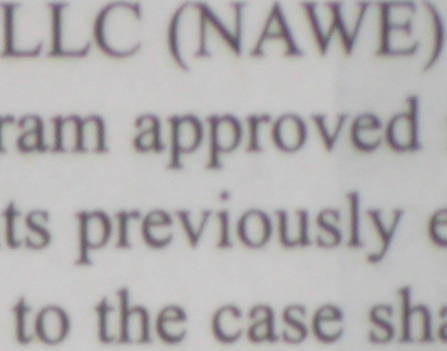
|
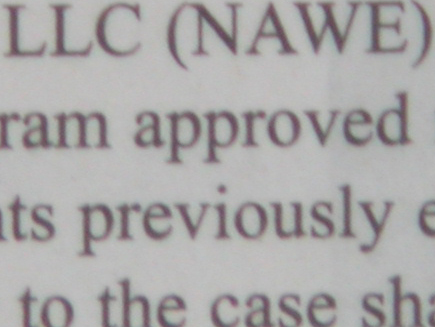
|
|
| TelescoMicro | |
Kenko 6X |
The following are the upper-right portion. As always, Kenko's performance is poor. The result is soft and has significant chromatic aberration as shown by greenish and bluish fringes along the right side and left side of each letter. Apparently, light fall-off of the TelescoMicro is more significant than that of the Kenko 6X, because the upper-right corner of TelescoMicro is darker than the Kenko one. However, the corner portion is sharper than the Kenko 6X one with very little (or no) chromatic aberration. It is interesting to point out that the sharpness in the upper-right corner of the TelescoMicro is softer than its center portion but not by much.
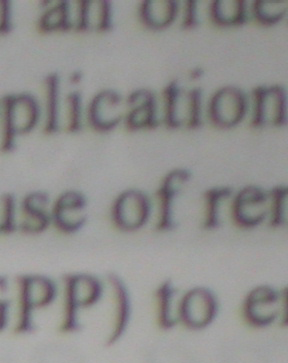
|
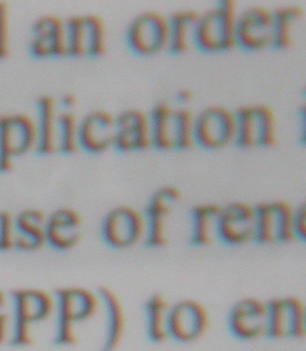
|
|
| TelescoMicro | |
Kenko 6X |
Push the focus ring out and the lens instantly becomes a close-up lens. A scale appears on the lens barrel indicating the close-up magnification. See the left image below. There are two sets of marks. On one side, we see 5X, 10X, 15X and 20X, which are the magnification scales without using the supplied close up lens (the right image below). On the other side, we see a mark CL, meaning these are magnification scales with the supplied close-up lens. Thus, with the supplied close-up lens, the magnification can go as high as 45X which is almost a microscope!

|
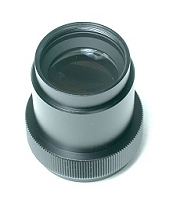
|
For higher magnification in the range of 30X and 45X, we should mount the supplied close-up lens on the monoscope. The monoscope has two front threads. The inner one, with a thread size of 24mm, is used with the close-up lens. See the left image below. After screwing the close-up lens on the monoscope, the lens is extended one inch as shown in the right image below. Once the close-up lens is mounted on the monoscope, one should use the second set of magnification scales (i.e., 30X to 45X).
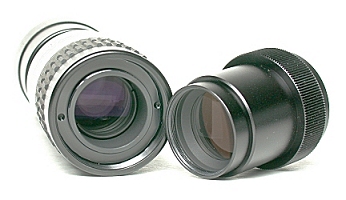
|
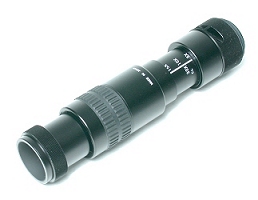
|
The monoscope also comes with a 32-37mm step-up ring for using 37mm accessories. See the left image below. Note that the outer thread of the monoscope is of 32mm. The right image below shows the step-ring on the lens.

|

|
This two-thread design is very convenient when using other accessories. Once the close-up lens is mounted, the minimum working distance is so short that perhaps no accessories can be used in front of the close-up lens. With the step-up ring, we can mount accessories on the step-ring, providing more flexibility. The following image shows the configuration with both step-up ring and close-up lens on the monoscope.
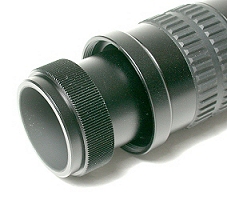
|
The left image below shows the configuration of mounting a Samigon FRL-1 Halo Ring Light on the lens, and the right one with the close-up lens. Since the front glass of the close-up lens is deeply recessed and shielded by the lens barrel, stray light will not enter the lens. This is a big plus!
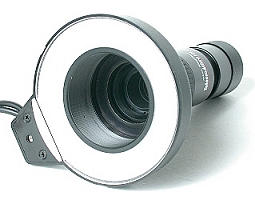
|
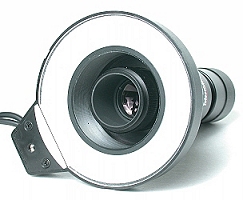
|
The following images of a 20-dollar note show the macro capability of the TelescoMicro and compare it against Raynox MSN-500 and Kenko 6X. The TelescoMicro image does not have an accurate white balance; however, I do not believe it matters because we are more concerned about its sharpness in the macro mode rather than the white balance issue. All shots were taken at about the minimum focusing distance of each lens. From the images, we learn that, in general, TelescoMicro is not as sharp as the 4500 in macro mode, which is expected because an add-on lens can only reduce the image quality of the combo. The magnification of the TelescoMicro is slightly smaller than the macro mode of the 4500, but not by much. The Raynox MSN-500 has the highest magnification ratio and is much sharper than the Kenko 6X which is too soft although its magnification is close to the MSN-500.

|
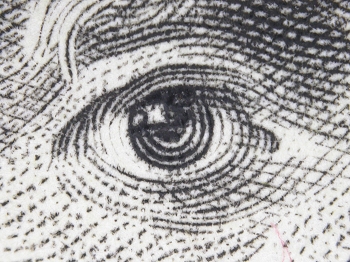
|
|
| 4500 F8.1 1/5 sec | 4500 and MSN-500 F10.3 1/16 sec | |
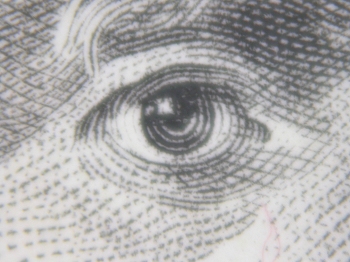
|

|
|
| Kenko 6X F8.2 1/14 sec | TelescoMicro non-Close-Up F8.2 1/18 sec | |
| Click here to download a compressed .zip file of the original images (4.22mb) | ||
The following shows the 5X, 10X, 15X, 20X and 30X images of Jackson's left eye of a 20-dollar note. Note that the close-up lens is required if magnification is higher than or equal to 30X. From these images, we learn that the micro capability of the TelescoMicro is very amazing. From these images, we also learn that the magnification of Raynox MSN-500 and Kenko 6X are about 10X and 7X, respectively. Image quality-wise, it seems the Raynox MSN-500 is a little sharper than the TelescoMicro at 10X, and the TelescoMicro beats the Kenko 6X miles. Thus, given the deficiency of a zoom micro lens, the performance of the TelescoMicro is rather impressive because it is not very far behind the fixed diopter Raynox MSN-500.
Please note that all images were taken with the same aperture F8.2. However, the shutter speed decreases as magnification increases. This is natural because the length of the lens extends when magnification increase. A longer lens barrel forces light to travel a longer distance, and, hence, reduces light intensity.

|
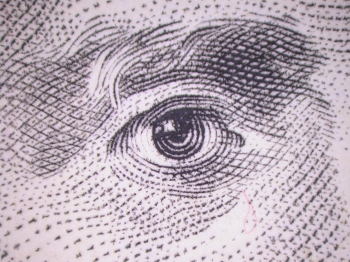
|
|
| non-Close-Up F8.2 1/18 sec | 5X F8.2 1/15 sec | |

|
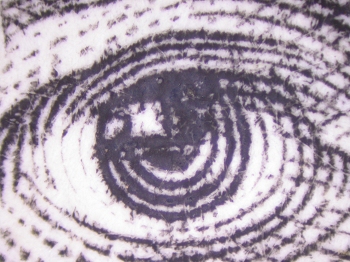
|
|
| 10X F8.2 1/12 sec | 15X F8.2 1/9 sec | |
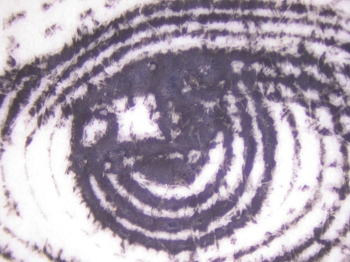
|
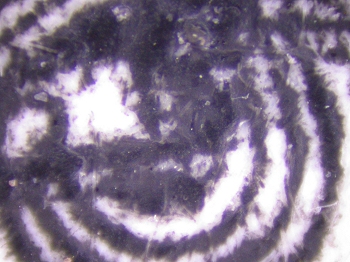
|
|
| 20X F8.2 1/8 sec | 30X F8.2 1/7 sec | |
| Click here to download a compressed .zip file of the original images (6.61mb) | ||
Next, we shall look at the maximum magnification of 45X. The four images below show the result. (I believe you know the location of these images. Otherwise, check it out with your 20-dollar note. The yellow box in the 4500 image indicates the area of the TelescoMicro 45X image. However, the MSN-500 and Kenko 6X images show the second "THE UNITED STATES OF AMERICA". As you can see, the microscopic close-up of TelescoMicro at 45X is quite impressive. Moreover, the sharpness of the Raynox MSN-500 is much batter than that of the Kenko 6X. However, it is difficult to judge how good the TelescoMicro at 45X is because the 4500 fails to auto-focus. Consequently, the 45X image was taken with manual focus, and, as everyone knows, it is very difficult to make sure the image is sharply focused due to lack of contrast. Therefore, I would suggest that the actual sharpness at 45X should be better but not by much.
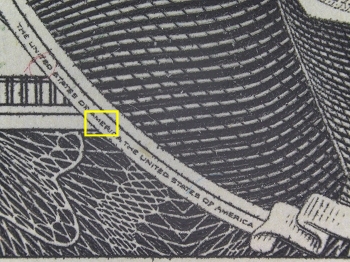
|
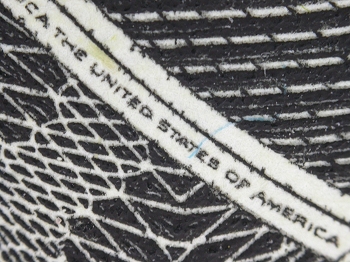
|
|
| 4500 F8.1 1/5 sec | 4500 and MSN-500 F10.3 1/21 sec | |
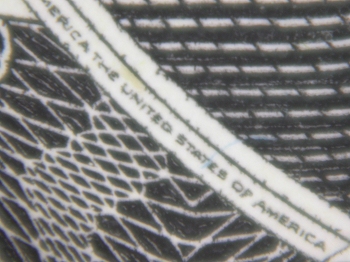
|
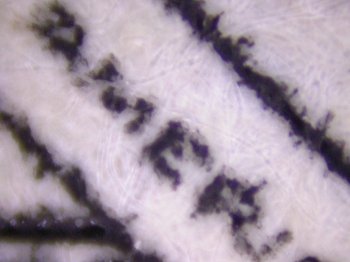
|
|
| Kenko 6X F8.2 1/13 sec | 45X F8.2 1/8 sec | |
| Click here to download a compressed .zip file of the original images (4.69mb) | ||
After using the TelescoMicro for a while, my findings are given below: